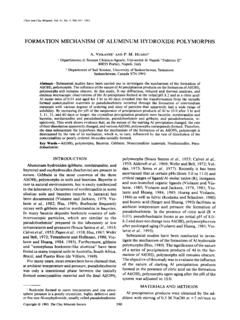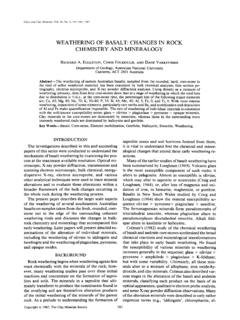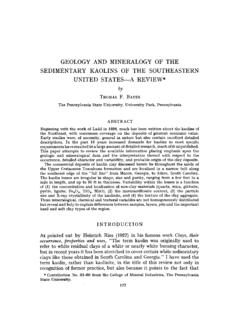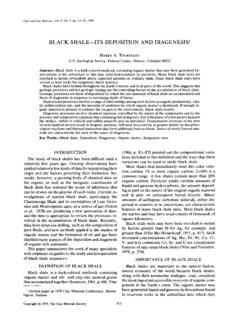Transcription of HYDROPHOBICITY OF SILOXANE SURFACES IN SMECTITES AS ...
1 Clays and Clay Minerals, Vol. 39, No. 4, 428-436, 1991. HYDROPHOBICITY OF SILOXANE SURFACES IN SMECTITES AS. revealed BY aromatic hydrocarbon adsorption . FROM water . W. F. JAYNES AND S. A. BOYD. Crop and Soil Science Department, Michigan State University East Lansing, Michigan 48824. Abstract--The nature of the SILOXANE surface in SMECTITES was investigated by measuring the adsorption of aromatic hydrocarbons from water by organo-clays. The organo-clays were prepared by replacing the hydrophilic, inorganic exchange cations of a series of SMECTITES with the small, hydrophobic organic cation, trimethylphenylammonium(TMPA). SMECTITES with a range in charge densities were used that resulted in different TMPA contents in the organo-clays. adsorption isotherms of benzene, alkylbenzenes, and naphthalene from water by the TMPA- SMECTITES indicated that sorption was inversely related to TMPA. content. The Langmuir form of the isotherms suggests that the aromatic compounds adsorb to the clay surface.
2 Possible adsorptive sites in TMPA- SMECTITES are limited to the TMPA cations and the SILOXANE oxygen SURFACES . Because sorption increased as layer charge and TMPA content decreased, the organic compounds must adsorb to the SILOXANE SURFACES . Calculations based on an adsorbed compound monolayer, which was estimated by fitting adsorption data to the Langmuir equation, and the N2 specific surface area of each TMPA-clay, indicate that the surface area occupied by each adsorbed molecule increases as the planar area of the molecule increases. This strongly indicates that the planar SURFACES of the compounds adsorb directly to the clay surface. Apparently, the TMPA cations function to keep the smectite interlayers open. Interactions between the phenyl groups of TMPA cations on opposing interlayer clay SURFACES may act to increase the size of the adsorptive regions. These results show that the SILOXANE SURFACES of SMECTITES can effectively adsorb aromatic hydrocarbons from water if the hydrophilic, inorganic exchange cations are replaced with small, hydrophobic organic cations.
3 The strong adsorption of hydrophobic organic molecules from water dem- onstrates the HYDROPHOBICITY of the SILOXANE SURFACES in SMECTITES . Key Words-- adsorption isotherm, Alkylbenzene, Benzene, Langmulr equation, Naphthalene, Organo- clay, Surface area. INTRODUCTION creased. He concluded that the hydrophilic character of the zeolite was caused by the alumina tetrahedra. Early research on clays emphasized the importance Farmer and Russell (1971) stated that because the of the surface silicate oxygens on water adsorption due negative charge in octahedrally-substituted clays must to hydrogen bonding (Hendricks and Jefferson, 1938; be distributed over at least 10 surface oxygens, these Bradley, 1945; Low, 1961). Conversely, Graham (1964) surface oxygens should be weaker electron donors concluded that the interlayer cations have a major ef- (Lewis bases) than those in tetrahedrally-substituted fect on fixing the sites of water adsorption , and that clays. Similarly, Sposito and Prost (1982) suggested the surface oxygens have only a m i n o r effect.
4 Similarly, that the surface oxygens in octahedrally-substituted Sposito a n d Prost (1982) concluded that the spatial SMECTITES should form weak hydrogen bonds with wa- arrangement of adsorbed water molecules is largely ter due to delocalization of the octahedral charge def- controlled by the exchangeable cations, but they argued icit. In contrast, Bleam (1990) maintained that the oc- that the role of the silicate surface cannot be neglected. tahedral charge deficit cannot be delocalized beyond The capability of the basal oxygens to form hydrogen the cation-oxygen coordination polyhedra. He further bonds with water (hydrophilicity) is determined by the argued that the surface oxygens both in octahedrally- Lewis base ( , electron pair donor) character of the substituted SMECTITES ( , montmorillonite, hectorite). (Si,A1)--O bonds. Sposito and Prost (1982), Sposito and neutral-layer phyUosilicates ( , talc, pyrophyl- (1984), and Bleam (1990) stated that the A1-O surface lite) should have Lewis basicities too low to hydrogen- oxygens in tetrahedrally-substituted phyllosilicates bond effectively.
5 Should have relatively strong Lewis basicities and would Neutral-layer phyllosilicates such as talc and pyro- be expected to form strong hydrogen bonds. Similarly, phyllite are known to be rather hydrophobic. However, Chert (1976) found that synthetic zeolites (mordenite) for SMECTITES , the strong hydration of metal exchange became more hydrophilic as the AI content was in- cations obscures the inherent hydrophilicity or hydro- Copyright 9 1991, The Clay MineralsSociety 428. Vol. 39, No. 4, 1991 HYDROPHOBICITY of SILOXANE SURFACES 429. phobicity of the SILOXANE SURFACES . If the hydrophilic sorptive sites and demonstrate the hydrophobic nature character of SMECTITES is due predominately to the ex- of these SURFACES . changeable metal cations, replacement of the inorganic cations with hydrophobic organic cations should great- MATERIALS AND METHODS. ly diminish the hydrophilic nature of the clay. This Samples might facilitate the direct adsorption of hydrophobic organic compounds to the clay surface.
6 Alternatively, A Wyoming montmorillonite (SAC) was obtained if the SILOXANE SURFACES are inherently hydrophilic, sig- from the American Colloid Company. Two other nificant adsorption of hydrophobic organic molecules SMECTITES , an Arizona montmorillonite (SAz) and a from water should not occur due to the preferential Washington nontronite (SWa) were obtained from the adsorption of water . Source Clays Repository of The Clay Minerals Society. We have examined the sorptive removal of hydro- The < 2-~m fractions were obtained by wet sedimen- phobic organic contaminants from water by several tation and were subsequently Mg-saturated, frozen, and organo-clays formed by displacing the inorganic ex- freeze-dried. change cations with different organic cations. These Lithium charge reduction studies have shown that when small organic cations such as tetramethylammonium (TMA) are used, the A series of reduced-charge montmorillonites were clays act as surface adsorbents, although the nature of prepared from sample SAz by mixing Li-saturated and the adsorptive interaction is poorly understood.
7 Lee et Na-saturated clay suspensions in the ratios , aL (1989) found that the sorption of benzene from , , and according water by TMA- SMECTITES yielded a Langmuir-type iso- to the procedure described by Brindley and Ertem therm. However, sorption of alkylbenzenes by TMA- (1971). The suspensions were thoroughly mixed, quick- smectite decreased sharply as the size of the alkyl sub- frozen, and freeze-dried. The freeze-dried clays were stituent increased, resulting in a variety of isotherm later heated in beakers at 250~ for 8-12 hours. These types. Jaynes and Boyd (1990) found that organo- reduced-charge clays are subsequently referred to as SMECTITES formed using trimethylphenylammonium , , , and , re- (TMPA) consistently yielded Langmuir-type isotherms spectively. Jaynes and Bigham (1987) found that the for benzene and many alkylbenzenes. Giles et al. (1960) cation-exchange capacity (CEC) of heated, Li/Na-sat- stated that Langmuir-type isotherms (L curves) are urated SAz clay was directly proportional to the ex- usually indicative of molecules adsorbed fiat on the changeable Li fraction prior to 250~ heating.
8 Hence, surface. the CEC of the reduced-charge clays was estimated to The adsorptive behavior of TMA- and TMPA-smec- be , , , and times the CEC of the natural tites are in direct contrast to the partition behavior of clay ( , estimated CECs = 91, 52, 26, and 13 meq/. organo-clays made with large organic cations such as 100 g), respectively. A cation-exchange capacity of 13. hexadecyltrimethylammonium (HDTMA). The effec- meq/100 g was assumed for the clay to allow tiveness of HDTMA- SMECTITES as sorbents of alkyl- for any residual charge due to tetrahedral substitutions benzenes was increased if high-charge clays were used. and crystal edge sites. Sorption was enhanced by the greater basal spacings and greater organic carbon contents of the high-charge Organo-clay preparation HDTMA-clays (Jaynes and Boyd, 1991). In contrast, Trimethylphenylammonium (TMPA) organo-clays Lee et al. (1990) and Jaynes and Boyd (1990) found were prepared by adding quantities of TMPA chloride that the adsorptive capacity of TMA- and TMPA- equal to 5-10 times the CEC of the clay.
9 The TMPA. SMECTITES for aromatic hydrocarbons was much greater chloride was dissolved in distilled water and added to for organo- SMECTITES formed from low-charge rather clay suspensions that were agitated on a magnetic stir- than high-charge SMECTITES . rer. After mixing for 4 hours, the TMPA clay suspen- The objective of this study was to determine the sions were sealed in dialysis tubing and dialyzed in nature of the adsorptive interaction of aromatic hy- distilled water until a chloride test with mgNO 3 indi- drocarbons with TMPA-smectite. To this end, the cated that the samples were free of salts. sorptive removal of several aromatic hydrocarbons Organo-clays were also prepared from the reduced- from water by TMPA- SMECTITES was evaluated using charge clays. However, the reduced-charge clays were adsorption isotherms. The montmorillonite charge re- first ultrasonically dispersed in 1:1 ethanol/ water to duction technique of Hofmann and Klemen (1950) was promote reexpansion prior to TMPA exchange.
10 Brind- used to prepare reduced-charge montmorillonites and ley and Ertem (1971) found that this treatment would determine whether the greater sorptivity of low-charge effectively reexpand reduced-charge clays. Trimethyl- TMPA- SMECTITES is increased by further decreases in phenylammonium chloride was dissolved in ethanol layer charge and thus TMPA content. Our results show and mixed with the reduced-charge clay suspensions that the SILOXANE SURFACES are the most probable ad- in an amount equal to 10 times the estimated CEC. 430 Jaynes and Boyd Clays and Clay Minerals The suspensions were placed on a reciprocating shaker the CSz extract containing the extracted c o m p o u n d was for 8-12 hours and were subsequently sealed in dialysis then analyzed using gas chromatography. tubing and dialyzed as above until free o f salts. The Isotherms were constructed by plotting the amounts resulting suspensions o f the natural and reduced-charge sorbed (Q) versus the concentrations remaining in so- TMPA-clays were quick-frozen and freeze-dried.















